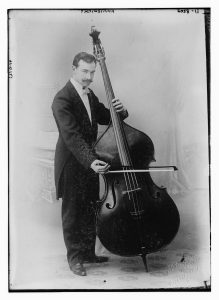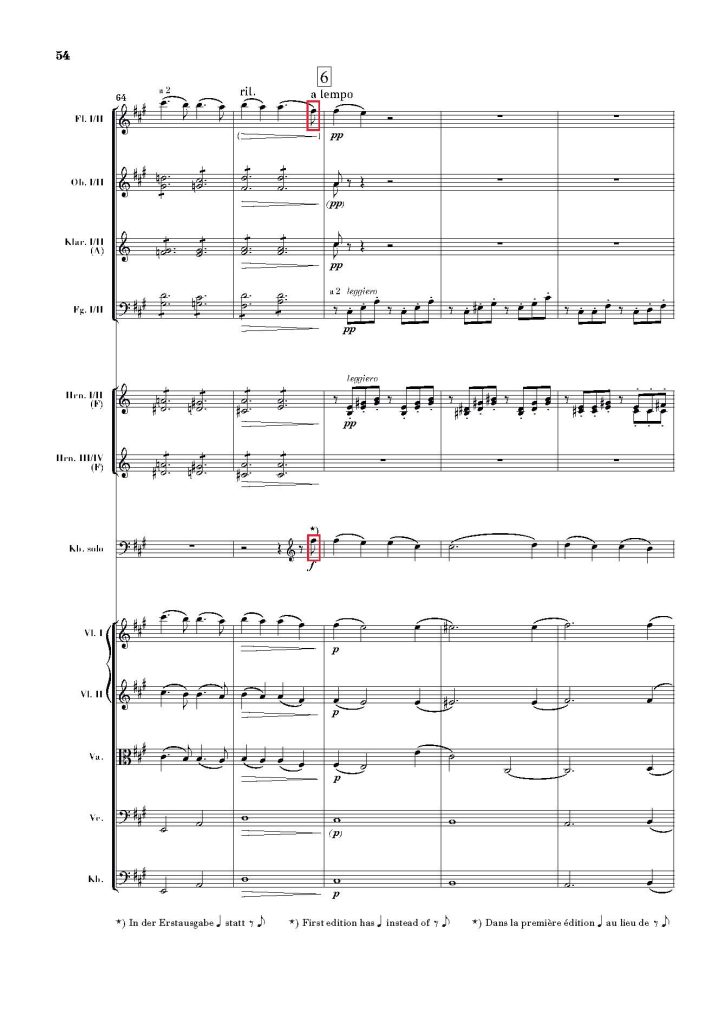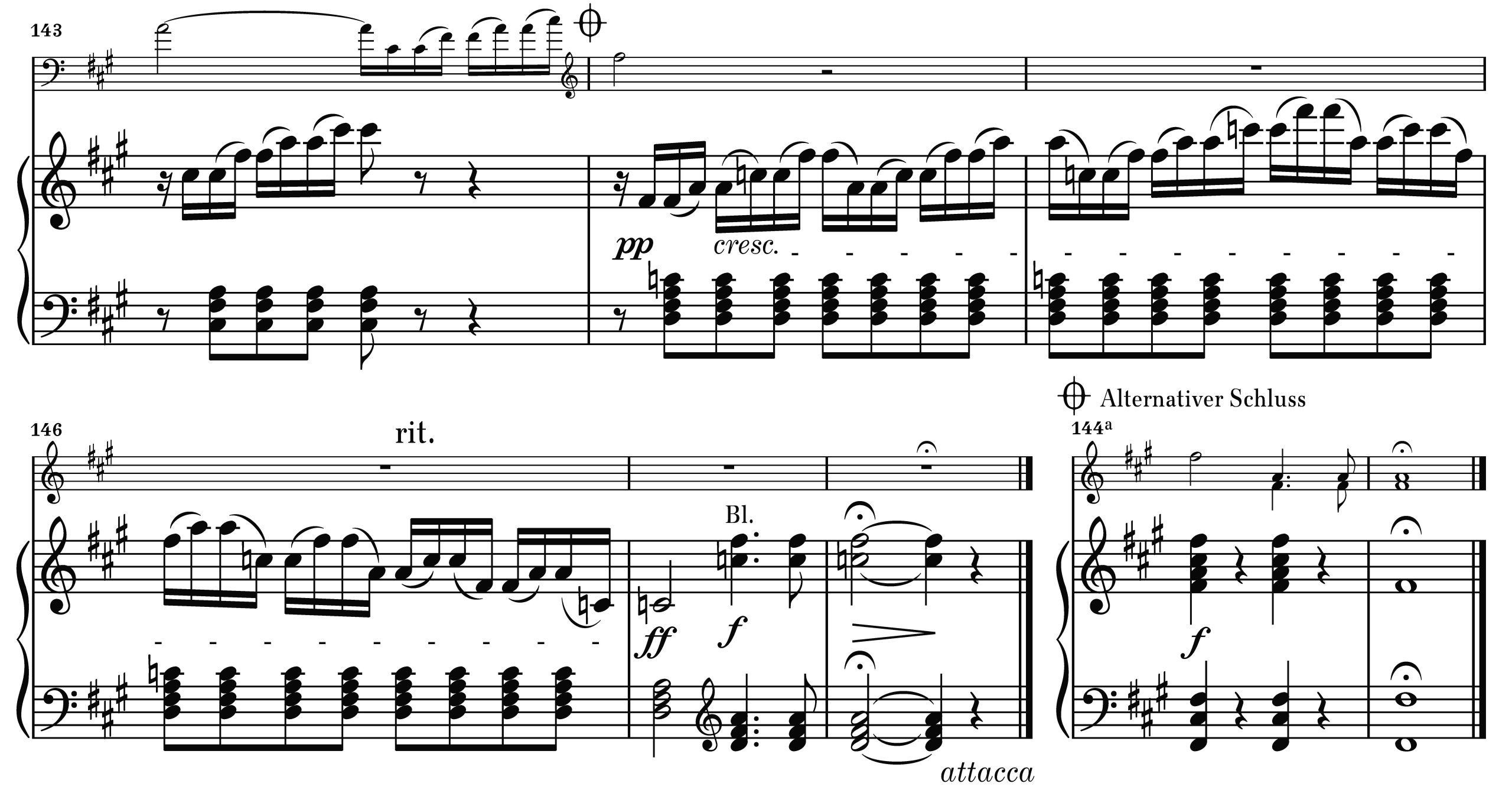Henle catalogue readers in the know are already aware that Dresden double bassist Tobias Glöckler regularly comes out with excellent new editions for his instrument. After classical solo concertos (Dittersdorf, Vanhal, Hoffmeister) and solo pieces from the 19th century (Dragonetti, Rossini, Saint-Saëns), he has now tackled one of the great Romantic concertos: Serge Koussevitzky’s Double Bass Concerto in F-sharp minor, premièred in Moscow in 1905 – one of the most important of all works in the bassist’s repertoire. The piano reduction and study edition of the full score were published a few weeks ago; the conductor’s score and orchestral material will soon be available from the Leipzig Hofmeister publishing house. With these editions, double bassists worldwide will now have a reliable basis for dealing with this central work. Editor Tobias Glöckler describes in an interview how much this has so far been missed.
Dear Mr Glöckler, incredible, but true: Every bassist is familiar with Serge Koussevitzky’s Double Bass Concerto op. 3, though the first Urtext edition is only just now appearing 120 years after its première. So, what’s the situation been like up to now?
Koussevitzky really hasn’t made it easy for us bassists. For decades we have had to rely on music editions essentially all going back to the 1906/07 first edition of the piano reduction. Unfortunately, this edition was teeming with errors and inconsistencies. Later editions did correct at least some of the most obvious errors, but much has remained contradictory. Above all: what am I supposed to play when my double bass part on the music desk clearly differs from the superimposed solo part in its accompanying piano reduction? Many double bassists have found individual solutions that work very well, as can regularly be experienced at competitions, auditions and on concert stages. Nevertheless, the uncertainty always remained – and not only for me: is that what Koussevitzky really meant?
How did you as editor deal with these contradictions?
Well, I first went in search of reliable sources. And lo and behold: Koussevitzky’s estate in the Washington, D.C., Library of Congress does not contain a piano reduction, but it does have a manuscript full score and likewise a manuscript set of parts, hitherto completely unnoticed! Both sources, written on Russian paper, were often used by Koussevitzky (probably also at the Moscow première). Thus, they are clearly authorised – unlike the contradictory first edition of the piano reduction. Already in the basic layer, the manuscript sources reveal many interesting and so far unknown details. It was then fascinating to follow how, during Koussevitzky performances, further annotations were made to the score and parts, that is, dynamics were added and errors corrected – in short, how a “definitive version” was successively created on the concert podium. In many places this version differs – sometimes even substantially – from what has been known from previous editions!
Can you give an example or two of precisely what that means?
Immediately catching the eye are the famous double-stop passages at the end of the 1st movement. From the piano reduction, we are used to simply repeating the first passage (measures 128–131) again after 4 measures (mm. 136–139). But there is a much more exciting version in the full-score manuscript from the Koussevitzky estate: the first passage initially continues the double-stop sequence consistently to the end (m. 131). Only in the second passage is a highly effective harmonic and dramaturgical increase achieved by changing the double-stops and by the then monophonic melodic line at the end of the passage (m. 139). Since the parts’ material in both measures also corresponds to the respective solo’s lower part, there is no doubt that Koussevitzky played both passages just that way:
And then, didn’t still other sources come into play?
Yes, that’s right: Two additional, unique sources were also included, that is, the audio recordings of the 2nd movement made by Koussevitzky himself in 1928 and 1929 on the then completely new gramophone-record medium.
Based on this, the question that had been discussed for decades, as to whether the end of the 2nd movement (mm. 91 ff.) should be played an octave higher in harmonics, differing from the piano reduction, could finally be satisfactorily clarified: both the full-score entries and Koussevitzky’s two audio recordings clearly demonstrate the octave playing in harmonics:
But not everything, certainly, was “wrong” in the previous editions?
Of course not! Apart from errors and inconsistencies, the first piano-reduction edition does contain musically reasonable variants of the full-score manuscript. A fine example of this occurs when the theme is resumed in m. 45 of the 1st and 3rd movements. Here, the full score changes the rhythm in the head of the theme by having the first note tied-over, whereas the first piano-reduction edition leaves it unchanged. Is this a writing error in the full score or a deliberate variation? Really difficult to decide….
An interesting detail is also to be pointed out in the 3rd movement: After an interlude, the solo double bass takes over the orchestra’s triumphal gesture (mm. 65 ff.). Here, too, the choice is tormenting: should a quarter-note upbeat be blended in to match the musical flow of the strings (variant in the piano reduction) or should the entry of the solo instrument with an eighth-note upbeat be deliberately emphasised (as in the full score)? The latter corresponds perfectly with the flutes and continues their line…
In your edition how did you deal with the various solo variants?
In principle, the new Urtext edition follows the two manuscript sources from Koussevitzky’s estate. Where the audio recordings or the piano reduction offer musically meaningful variants, these are superimposed directly on the main text in small print (as ossia) or described in footnotes. That way, the transmission differences become transparent at a glance, without the player’s having to consult the extensive Individual Comments. Every double bass player can thus freely choose the optimal variant for his or her interpretation! Equally welcome in the new edition’s solo part would also be the notation free of the tenor clef.
Do the manuscript sources and Koussevitzky’s audio recordings have practical performance consequences?
I would think so. The audio recordings are, in particular, extremely insightful historical documents, even though Koussevitzky himself was never really satisfied with them. Besides a very individual style of playing in terms of sound, vibrato and portamento, Koussevitzky’s so variable tempi are particularly surprising. This also applies, incidentally, to the outer movements, where the full score (unlike the piano reduction) also contains frequently changing tempo indications. This flexibility in tempo would also still be relevant in performance practice today. Another observation involves the unaccompanied solo passages at the openings of the 1st and 3rd movements, which today are often played very slowly, sometimes virtually spelled out note by note. In the full score, ties are notated here (mm. 7, 17), which – with all interpretive freedom – already set limits to a tempo already too slow in terms of bowing technique. In addition, accelerando is notated shortly before in the full score…
As a double bass player, I had privately hoped to discover a solo cadenza somewhere in the manuscripts. Nothing of the sort, unfortunately, can be found. In the sources there is otherwise no evidence of any kind that Koussevitzky ever played a cadenza in his performances.
What does the source situation mean for the Henle piano reduction?
An orchestral score was first prepared, involving the manuscript parts’ material, which was also published by Henle Verlag as a study edition. On this secure text basis, Christoph Sobanski then created a completely new, easily playable piano reduction, which is reproduced in two keys: one for solo and one for orchestral tuning of the double bass. Alongside many new details, there is a real surprise at the end of the 1st movement: pianists no longer have to rack their brains over ending the movement that in previous piano reductions passes attacca into the 2nd movement, when only the 1st movement is played (as is often the case in examinations or auditions). Extant in the sources is an effective “correct” ending for this, which was recognisably also played by Koussevitzky. This “Alternative ending” was, of course, included as an option in the Urtext edition:
Last, but not least: Doubts have always existed as to whether the concerto was really composed by Koussevitzky. Can you report anything new about this?
Not really. There is strong evidence that the concerto was largely written by Reinhold Glière (1875–1956). Koussevitzky publicly claimed for himself, on the other hand, composition of the concerto. Statements by contemporary witnesses also paint a contradictory picture (further details can be found in the Preface). Since no clear evidence to the contrary has been found, despite inspection of various sources (see the Comments) and extensive research – also in the direction of Glière – the new edition continues to assume that Koussevitzky was the work’s composer. By the way: for me as a musician, this issue is rather immaterial anyway, especially since it does not change anything about the music text. Whoever may have written the work – it is great music, and we double bass players are fortunate to have this concerto!
This fine closing statement leaves nothing to be added – many thanks, Mr Glöckler, for the interview!










